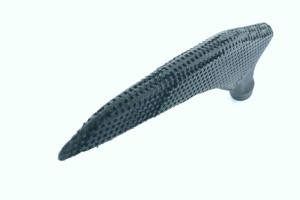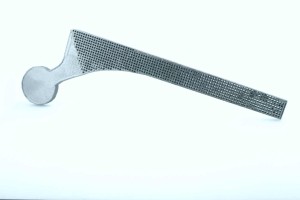 3D Lattice Proof of Concept
|
 Preliminary 2D Prototype |
Description
Bone resorption involves the destruction of bone tissue by osteoclasts with the release of minerals into the blood. The process is often caused by a lack of proper stimulus to the bone, which – being underloaded – can no longer remodel and maintain its mass. Bone resorption is ubiquitous in reconstructive orthopaedics and occurs for several reasons. One critical reason is when the mechanical properties of the implant do not match those of the surrounding host bone. Lack of mechanical biocompatibility is universally recognized to be a major detriment of all orthopaedic implants available in the market.
We have been working on the development of a femoral hip implant which displays isoelastic properties that are in seamless harmonization with those of the surrounding bone. The implant has heterogeneous property distribution achieved with a functionally graded open-cell lattice. High porosity with interconnected pores is achieved to allow bone tissue regeneration and stabilize the prosthesis. The implant hallmark lies in the controlled microarchitecture and mechanical properties (in particular the strain energy density), at each point tuned to those of the bone tissue. This ensures mechanical biocompatibility at the implant interface, as well as adequate interface porosity for osseointegration. We are currently addressing the manufacturing via Selective Laser Melting and clinical (both in vitro and in vivo) aspects to bring this implant to the market. The latter involves the clinical characterization of bone tissue response as a function of time and pore architecture. The results from this research are instrumental to the design a new set of mechanically biocompatible implants for bone replacements.
Relevant Publications
- Arabnejad S, Johnston B, Tanzer M, Pasini D, Fully Porous 3D Printed Titanium Femoral Stem to Reduce Stress-shielding Following Total Hip Arthroplasty, Journal of Orthopaedic Research, Vol 35 (8), 1774–1783, 2017.
- Khanoki Sajad A., Pasini, D., Fatigue design of a mechanically biocompatible lattice for a proof-of-concept femoral stem, Journal of the Mechanical Behavior of Biomedical Materials, Vol. 22, pp. 65-83, 2013. link to PDF
- Khanoki, S. A., Pasini, D., The Fatigue Design of a Bone Preserving Hip Implant with Functionally Graded Cellular Material, ASME Journal of Medical Devices, Vol. 7(2), 020908, 2013.
- Khanoki Sajad A., Pasini, D., Multiscale Design and Multiobjective Optimization of Orthopaedic Hip Implants with Functionally Graded Cellular Material, Journal of Biomechanical Engineering, vol 134 (3), 2012. link to PDF